The Observer view on Ukraine and the climate emergency
Observer editorial
Sat, 5 March 2022,

Photograph: Kacper Pempel/Reuters
The crisis must not become a reason to drop our commitment to net zero target
The report last week by the Intergovernmental Panel on Climate Change (IPCC) on the need to adapt to global warming made stark, unpleasant reading. Described by the UN secretary general, António Guterres, as “an atlas of human suffering”, it revealed that billions of people now live in parts of the world where they are highly vulnerable to climate change.
Death tolls from droughts, floods and storms are destined to increase in these regions as extreme heat events and inundations become more frequent. Only urgent action today can halt the worst impacts and prevent a global calamity, argued the IPCC.
Related: Q&A: Has the IPCC’s bleak warning of climate breakdown been heard?
In a normal news week, warnings as dire as these would have made front-page headlines in British newspapers. Events in Ukraine ensured they were pushed inside, however. It is not surprising that the unfolding humanitarian crisis occurring in eastern Europe should be the prime focus of our attention and concern. However, there is a danger that the battle for Ukraine may divert attention from the approaching climate change crisis. Even before Russia launched its invasion and triggered a leap in fuel prices, some Conservative backbench MPs had been pressing for the government to cut back its green agenda, a move that has since been followed with calls for fracking to be resumed in the UK in order to boost fossil fuel production and help curb fuel price increases.
These manoeuvres are being mounted by a collection of MPs and peers known as the Net Zero Scrutiny Group. They have tried to blame the government’s green agenda for a cost-of-living crisis, which they say would be better addressed not by raising national insurance payments and imposing green levies but by cutting taxes, resuming UK shale gas extraction, and slowing down the rate at which we impose carbon emission cuts.
Nor are these campaigns confined to the UK. Across the EU, calls have been made for the bloc to reactivate old, decommissioned coal plants “as a precaution and in order to be prepared for the worst”, as the German economy minister, Robert Habeck, said last week.
Across the EU, calls have been made for the bloc to reactivate old, decommissioned coal plants ‘as a precaution’
Such proposals are alarming and the threats they pose should be made clear to the public. In the case of shale gas production, there is simply not enough in the UK to make up for the decline in our reserves of North Sea gas, which have been occurring for more than a decade. Fracking is also deeply unpopular with the public and given that any shale gas extracted would have to be sold at international market prices, it would have no impact on UK fuel bills. Shale gas has no part to play in the generation of power in a Britain committed to playing a leading role in the battle against global warming.
Nor is it realistic to consider reopening coal plants. Coal is the dirtiest of all fossil fuels and any return to its widescale burning across Europe would send the worst possible message to developing nations currently resisting pressure to close down mines and ancient power plants as part of the international programme aimed at cutting back carbon emissions.
The real lesson from the battlefields of Ukraine is that Britain needs to rid itself of its fossil fuel addiction entirely and become self-reliant on electricity that is generated cleanly and efficiently. We need to do that to protect our energy supplies, while at the same time sending a message to the rest of the world that we take the coming crisis extremely seriously. The need to follow this course of action is reflected in the final words of last week’s IPCC report: “Any further delay in concrete anticipatory global action on adaptation and mitigation will miss a brief and rapidly closing window of opportunity to secure a livable and sustainable future for all.”
Defiant to the last, Moscow’s media star takes aim at Putin’s brutal clampdown
Natalya Sindeyeva, the founder of Dozhd, struggled to the last but her TV station has been silenced – for now
Two Sundays ago I wrote in the Observer about the last remaining Russian independent TV station, Dozhd (“TV Rain”), and the irrepressible spirit of Natalya Sindeyeva, the woman who pioneered and ran it. Keeping the station alive had cost Sindeyeva her home and her marriage and her health and her security. A dozen years ago when she launched Dozhd she had been a vivid Russian celebrity, a “dancing queen” of Moscow’s elite party circuit, now her mugshot is posted on street corners as a “foreign agent”. The defiant struggles of Dozhd to stay on air and to continue to report the truth in Russia despite years of intimidation and sanction from the Kremlin were the subject of an inspiring documentary, “F@ck This Job (Tango with Putin)”, made by London-based Vera Krichevskaya, which was released in the UK last week and broadcast on the BBC.
A few days after “F@ck this Job” came out, on Friday, the decade-long defiance of Dozhd was silenced, at least for a while, by a brutal new law, passed unanimously in the Russian parliament, which bans news organisations from reporting anything except state approved press releases (it is now illegal for any broadcaster to call events in Ukraine, for example, “a war”). The new legislation, which has also caused the BBC and most other news organisations to suspend its reporting in Russia, will see journalists and media owners who contravene it jailed for up to 15 years. BBC director general Tim Davie said the law “appears to criminalise the process of independent journalism”. Its most chilling effects have been felt among the few surviving liberal Russian media outlets like Dozhd and Novaya Gazeta, whose editor, Dmitry Muratov, winner of last year’s Nobel Peace Prize, announced that the paper’s website had been forced to remove all of its material on Russia’s invasion of Ukraine, saying “there is no doubt that the threat [of prosecution] will be realised”.
On Friday afternoon I spoke by Zoom to Natalya Sindeyeva and Dozhd’s deputy news editor, Dmitry Elovsky, and the documentary maker Vera Krichevskaya. They appeared ashen-faced on screen, all still struggling to process exactly what had happened. The law against what the Kremlin inevitably described as “fake news” had, they said, “changed everything overnight” within Russia. How did the authorities define “fake news”? I asked. “Anything that is true,” Sindeyeva said.
Last weekend Sindeyeva had been in London to attend the first sold-out screenings of “F@ck this Job”. She had returned hurriedly to Moscow on Monday after sanctions against Russia had been announced, to be with her children when it first seemed likely that borders might close. On the plane back home, she suggested, she still believed that Dozhd could continue to broadcast to its millions of Russian viewers – at least on the YouTube channel to which it had long been confined.
By Wednesday, that no longer felt possible. Dozhd’s editor-in-chief Tikhon Dzaydko and his wife had been receiving vicious death threats all week, after their contact details had been distributed online. They decided they had no choice but to leave the country. Sindeyeva was hearing a number of reports that “special police forces were heading to our newsroom along with pro-Kremlin mobsters”. Krichevsakya had crossed the border from Finland by car the previous day to attend a planned premiere of “F@ck this Job” at Moscow’s largest cinema. Only a few hours before that event was due to begin she received a call that the premiere – and the screening of the film across the country – had been cancelled in light of bomb threats. When we spoke, the director had managed to escape Russia and get a flight to Istanbul and then another to Tel Aviv. Sindeyeva and Elovsky did not disclose their locations.

Journalists working in the newsroom of Dozhd (Rain TV) in August 2021. Photograph: Denis Kaminev/AP
When Sindeyeva had launched Dozhd as “the optimistic channel” a dozen years ago, during the brief window of greater openness that attended Dmitry Medvedev’s presidency, she sought to create a vivid space in which a vision of a progressive Russia might exist. The channel would celebrate youth and tolerance. It remained a champion of gay rights when new laws were brought in that criminalised the “promotion” of same-sex relationships. It courageously reported from Chechnya and Ukraine and gave a platform to opposition leaders Boris Nemtsov (before his murder in 2015) and Alexei Navalny. Sindeyeva’s inextinguishable sense of a brighter future kept it going. Two weeks ago, she told me “I’ve always been optimistic and I’m still optimistic. For me, this means that the good guys will take over eventually. But also there is one more important thing to say about that. Optimism is not dreaming, it also says, ‘Get your ass up from the chair and try to make things happen.’”
A fortnight on a lot of that spirit had been drained from her, at least temporarily. “Now,” she told me on Friday, “for the first time ever, I have no hope. I cried all morning on Wednesday, before going into the office for the meeting at which we decided to cease broadcasting.” Her tears had given way to characteristic solidarity with her station’s staff who had never before missed a news bulletin despite, over the years, being kicked off networks and hounded out of their offices. They had even for a while set up a full news studio in Sindeyeva’s Moscow apartment. Closing down felt, Sindeyeva said, “like the decision a mother has to make in a war, to hide her kids in the basement”.
Related: Eminent writers urge Russian speakers to tell truth of war in Ukraine
For their last broadcast Sindeyeva joined the entire news team in front of the camera to say goodbye to viewers. “No to war,” she said, as a farewell, with a bleak smile. The station then cut to some old footage from the ballet Swan Lake, an ironic gesture to the films that Soviet state television had once routinely broadcast when news was censored.
By Wednesday night, Sindeyeva and Elovsky were watching the lights go out on information channels and websites in Moscow one by one, first YouTube feeds then Facebook. “It was so sad,” Krichevskaya said, “to wake up on Thursday morning with none of my usual notifications from Dozhd.” Overnight, the only source of independent news in Russia had become Telegram posts on which friends and colleagues shared fears that the borders would soon be closed. A plane on which Krichevskaya’s mother was travelling from St Petersburg was diverted and grounded for 13 hours while passenger details were checked. All the talk between journalists, Elovsky said, was how to effectively erase media histories from phones and computers in light of the new law. “It feels like an iron curtain is returning,” he said.
Sindeyeva, with a weary note of defiance, insisted that she saw the closure of Dozhd as a pause rather than anything more permanent. She had seen imprisoned opposition leader Alexei Navalny’s call for Russian citizens to take to the streets to protest Putin’s war, but she doubted it had been heard widely. “People are panicking, they don’t know what will happen next,” she said, “And now there is no way for them to hear news that might tell them.”
Russia ally Kazakhstan permits large pro-Ukraine rally amid sanctions fears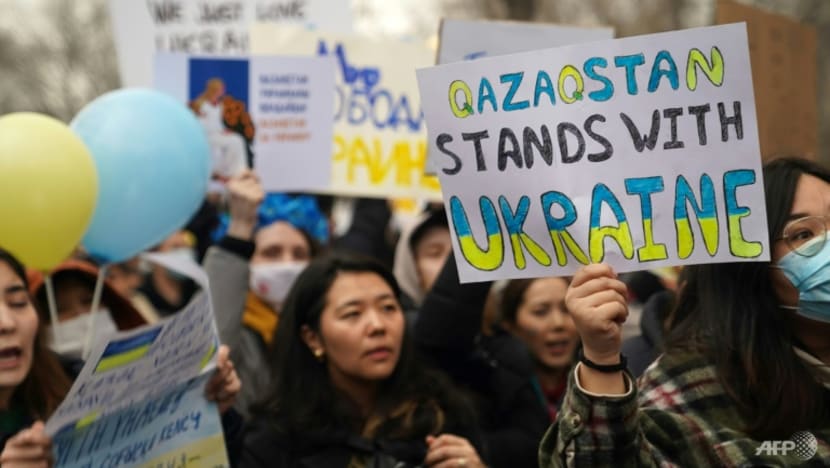
Demonstrators showed their support for Ukraine at a rally in Almaty, capital of Russian ally Kazakhstan (Photo: AFP/Malika AUTALIPOVA)
Issued on: 06/03/2022 -
Almaty (Kazakhstan) (AFP) – Russia's ally Kazakhstan permitted a large peace rally in its biggest city Saturday as authorities in the Central Asian country look to distance themselves from Moscow's sanctions-triggering military invasion of Ukraine.
Ex-Soviet Kazakhstan's regime regularly blocks political demonstrations but has appeared spooked by suggestions that unprecedented Western sanctions against Russia over Ukraine should target Moscow's allies too.
The Kazakh foreign ministry has stressed its neutrality in the conflict and this week invited Britain's ambassador for talks after a UK lawmaker on Monday appeared to call for sanctions against individuals in the country "complicit and supporting" Russian leader Vladimir Putin.
The protest in Almaty, a financial hub of 1.8 million people, gathered over 2,000 demonstrators, who stood for the Ukrainian national anthem and chanted pro-peace slogans and insults against Putin.
Kazakhstan's foreign ministry on Saturday said it had received assurances from London that the country would not be sanctioned by the United Kingdom over Russia's invasion.
City of Science: Looking to the past, present and future of healthcare and the human body
Yvonne Slater
Fri, 4 March 2022

Images from Pixabay
IT'S a healthy thing to reflect on the past to appreciate where we are today; in our own lives, in our professions, and in our world.
In terms of medicine and understanding the human body, we have come a long way as a human race. Yvonne Slater from Glasgow Science Centre and Kirsty Earley from The Royal College of Physicians and Surgeons of Glasgow are looking to the past, present and future of healthcare and the human body.
So much of the past is reflected in current clinical practice, influencing not only the physical, but also the emotional and spiritual components of healthcare. Take it back to the Ancient Greeks with the Hippocratic Oath, an ethical code that many practitioners hold to today, or the theory of antisepsis, which was discovered in Glasgow in 1867 and underpins our understanding of the importance of hygiene. Or how about the discovery of anaesthesia in the mid-1800s, or the foundation of medical imaging through the discovery of X-radiation in 1895? It is through the lens of history that we are able to appreciate these fundamental components of clinical practice on another level. Without the pioneering work of individuals such as Joseph Lister in antisepsis and infection control, Marie Curie in radiation and medical imaging, and William Macewen in brain surgery, we would be stuck in the past where tradition trumped evidence.
READ MORE: Glasgow Science Centre: The unexpected reason that love really is written in the stars
Throughout the rapid medical advances of the 20th Century we continued to fight infection, with the discovery of penicillin and further antibiotics, the delivery of effective vaccination programs and an increased understanding of the immune system. We harnessed the potential of radiation therapy and chemotherapy as treatments for cancer and developed new ways to see under the skin and explore the human body with ultrasound, MRI and other non-invasive scanning technologies. We successfully carried out life-saving organ transplants, extended the average human lifespan and moved the focus from surviving disease to keeping healthy.
The 20th century also brought another change in approach. Increasing access to international travel and rapid worldwide communication meant scientists and clinicians could more easily share ideas and knowledge. Teamwork and collaboration have become vital, moving us away from a focus on individual pioneers. But it is still on their shoulders that we are standing today. We still look to the past to ground us in today and to allow us to glimpse into the future.
READ MORE: Glasgow Science Centre: Step outside and look up for the ultimate festive light show
Today, keywords in modern healthcare are DNA, data and digital. We can swallow a camera pill and track its progress through the digestive system as it sends back images and data about our gut health. We can train computer algorithms with large amounts of data so that they can quickly analyse and recognise patterns. This application of artificial intelligence will speed up the process of diagnosis and treatment decisions, through the rapid scanning of x-rays and images to accurately detect fractures, certain cancers or acute stroke, for example. The possibilities of personalised medicine are coming ever closer, where having knowledge of patients’ DNA means that treatment can be tailored for the individual, delivering the most appropriate medicine at the right dose and at the right time.
And looking to the future, we are living longer, exploring further. Many of us already use wearable digital devices that track our sleep, our heart rate and level of activity. In future, wearing smart sensors may enable people with long term conditions, and their care team, to more closely monitor their health and allow earlier identification of risks and intervention. With longer lifespans, the use of smart technology, coupled with the advance of personalised medicine will help us support more independent living in later life.
We are planning to return to the Moon and establish long term missions to explore its surface, with the added possibility of sending astronauts from there to Mars. Through studying the health of astronauts, we are learning what happens to the human body after long periods in space and how we might adapt in future. Maybe some of us alive today will spend time living on other planets in the future and will be the ones reflecting on the medical challenges this has brought for the next generation of scientific pioneers to solve.
You can explore these stories of healthcare and the human body with Glasgow Science Centre’s online festival, Curious About: The Human Body, from 9 – 11 March 2022. Join in live talks or delve into a wealth of activities and videos by visiting the Curious About website HERE.
Ancient underwater landslide caused huge tsunami ‘and could serve as a warning’
Rob Waugh
·Contributor
Mon, 28 February 2022,
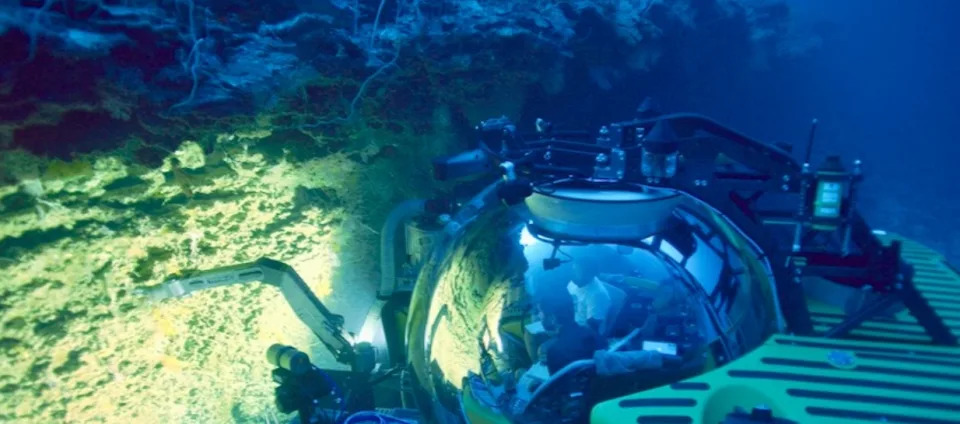
The find suggested that an ancient landslide caused a tsunami. (Getty)
An ancient underwater landslide which caused a huge tsunami could serve as a warning for many nations in the Middle East.
A huge chasm in the seafloor was caused by a landslide 500 years ago which unleashed a tsunami in the area.
A researcher from the University of Miami Rosenstiel School of Marine and Atmospheric Science have warned that future movement of the seabed could unleash more tsunamis in the area in countries including Saudi Arabia and Egypt.
Earth scientist Sam Purkis, professor and chair of the Department of Marine Geosciences, spent four weeks aboard the OceanXplorer research vessel in the region.
As he and a fellow scientist were ascending from 3,000 feet during a submersible dive, Purkis noticed a startling break in the seabed.
It was an unexpected find, although not out of the question for the Red Sea, which was formed by the separation of the African and Arabian tectonic plates 30 million years ago.
Purkis said: “Immediately, I realised that what we were looking at was the result of some geological force, which had broken the seafloor.
He took rock samples, which revealed that it had been created by a landslide that likely occurred 500 years ago.
He was also able to find evidence from sediment collected north of the chasm, which showed that it probably spawned a tsunami.
Purkis warns that the nations along its coasts—including Egypt, Jordan, Saudi Arabia, and Israel—need to ensure that early warning systems are in place for both earthquakes and tsunami.
“Just a little shake in the wrong place and the whole wall could fail, leading to a much larger tsunami than occurred 500 years ago,” Purkis said.
“That area of Egypt, as well as Saudi Arabia, which are urbanising so rapidly, have certain hazards which haven’t been previously recognized, but they need to be, to avoid a future catastrophe.”
In 2018, geographers working in Shetland found evidence of two previously unknown tsunamis that hit the islands - hinting that Britain could face a far higher tsunami risk than previously believed.
Previously, it had been believed that the devastation unleashed by the ‘Storegga Slide’, an underwater landslide off Norway 8,000 years ago, had been a near-unique event.
Sue Dawson, from the University of Dundee, said, "We found sands aged 5,000 and 1,500 years old at multiple locations in Shetland, up to 43 feet above sea level.
"These deposits have a similar sediment character as the Storegga event and can therefore be linked to tsunami inundation."
The researchers analysed sand debris in lochs in Shetland to make their conclusion.
Earth’s coldest forests are shifting northwards and it could make climate change even worse
Rob Waugh
·Contributor
Mon, 28 February 2022
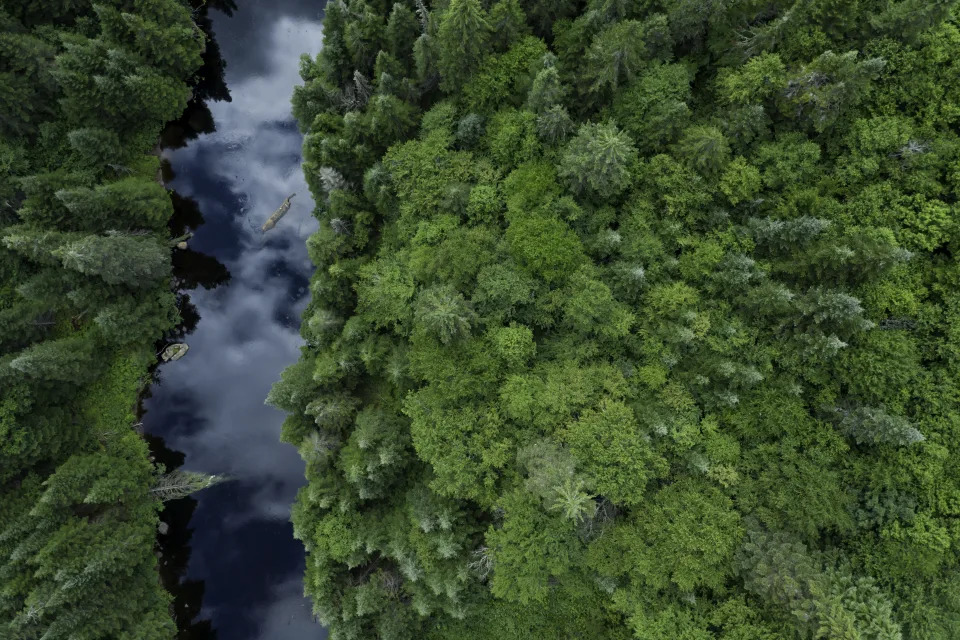
Boreal forests are moving northwards (Getty)
The coldest forests on our planet are shifting northwards, due to climate change - and the shift could cause new dangers.
Researchers have warned that the movement of conifer forests to the north is visible on satellites and could lead to increased wildfires and new risks to biodiversity.
The researchers also warn that the change could have knock-on effects which could accelerate climate change.
The boreal forest is a belt of cold-tolerant conifer trees that stretches nearly 9,000 miles across northern North America and Eurasia.
Read more: Why economists worry that reversing climate change is hopeless
The boreal forest accounts for almost a quarter of the Earth's forest area and is the coldest forest - though mostly rapidly warming.
Logan Berner, assistant research professor in the School of Informatics, Computing, and Cyber Systems (SICCS) at Northern Arizona University, says: "There is emerging evidence that climate change is causing boreal trees and shrubs to expand into arctic and alpine tundra, while at the same time causing trees to become more stressed and die along the warm southern margins of the boreal forest.
"These dynamics could lead to a gradual northward shift in the geographic extent of the boreal forest biome, but the extent to which such changes are already underway has remained unclear."
The researchers used 40 years of satellite observations and various geospatial climate-related datasets of the boreal forest and assessed where and why vegetation greened and browned during recent decades.
Read more: A 1988 warning about climate change was mostly right
"Greening" indicates higher rates of vegetation growth, which can happen when climate warming promotes growth of trees and shrubs.
"Browning" indicates lower rates of vegetation growth and potentially vegetation death, such as when hotter and drier conditions suppress tree growth and kill trees.
Vegetation became greener across much of the cold northern margins of the boreal forest; warmer conditions led to increased vegetation growth and enabled trees and shrubs to expand into arctic and alpine tundra.
Vegetation became browner along parts of the warm southern margins of this biome as a result of hotter, drier conditions increasing tree stress and death.
Co-author Scott Goetz, Regents' professor and director of the GEODE Lab, said, "The boreal forest ecosystem is changing in many ways over recent decades, and those changes are often linked with increasing fire disturbance.
"Here we intentionally focused on areas that were not recently disturbed by fire so we could tease out the effect of climate change.
“Our hypotheses about what would happen were verified by this analysis - forests are getting more productive in the cooler northern and higher elevation areas, and they're getting less productive as a result of hot air masses and drying in the warmer and more southerly areas. We fully expect that will continue and probably intensify in the years to come."
Read more: Melting snow in Himalayas drives growth of green sea slime visible from space
Changes in vegetation could affect both plant and animal biodiversity, especially species like caribou and moose, which have specific foraging preferences like deciduous shrubs and trees.
Changes in vegetation also impact the stability of carbon-rich permafrost soils and absorption of solar energy by the land surface in ways that could accelerate climate warming.
Increasing tree mortality could have widespread implications for forest products while also leading to further degradation of semi-continuous and sporadic permafrost.
Berner said, "Fundamentally, greenhouse gas emissions from human activities are causing Earth's climate to warm, which in turn is leading the boreal forest to shift northward, as well as impacting other ecosystems across the planet"
"To minimise adverse impacts of climate change, efforts are needed to dramatically reduce greenhouse gas emissions, especially related to fossil fuel consumption and deforestation.
“Furthermore, northern communities need to plan for potential changes in vegetation that could impact resource availability (e.g. wildlife, timber) and wildfire risk."
UK'Silenced!' Muslim MP shut down in Parliament while asking about 'government's disgusting racism'
Nadine Batchelor-Hunt
·Political Correspondent - Yahoo News UK
23 February 2022·
A Muslim MP was cut off in the House of Commons while asking why a senior Conservative MP was promoted amid allegations of Islamophobia.
Mark Spencer was made Commons Leader earlier this month despite an investigation being carried out into allegations made by Tory MP Nusrat Ghani.
Spencer identified himself as the whip at the centre of a row over whether Ms Ghani was told her “Muslimness” was a factor in losing a ministerial role in 2020.
Spencer has strongly denied the claims, calling them "completely false" and "defamatory".
Addressing Boris Johnson during prime minister's questions on Wednesday, Labour MP Imran Hussain referenced the situation, and remarked on Johnson's own controversial comments - in which he has previously compared Muslim women to "letterboxes and "bankrobbers".
"The member for Sherwood [Mark Spencer] is currently under investigation for Islamophobia following accusations he told a fellow MP that her being a Muslim MP was making colleagues uncomfortable," Hussain said.
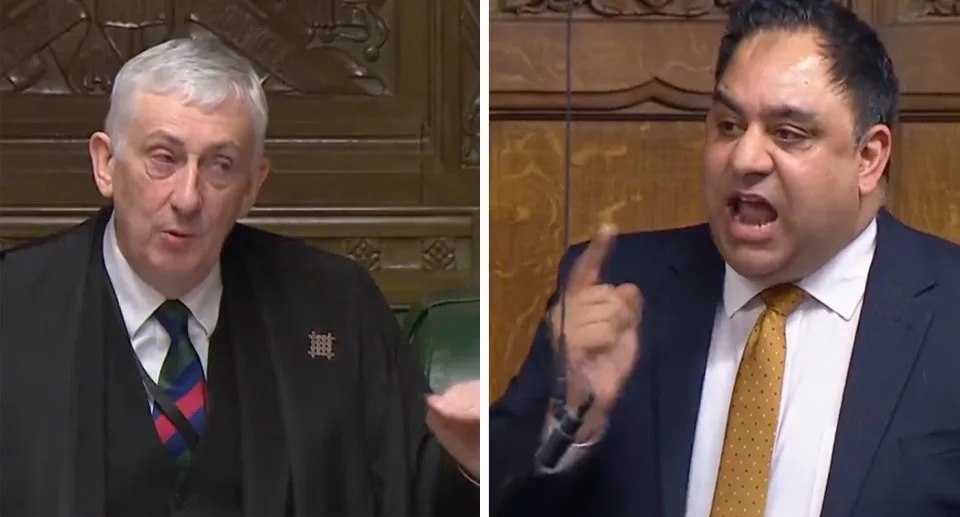
Labour MP Imran Hussain was shut down by speaker Lindsay Hoyle for asking about accusations of Islamaphobia on the part of Commons Leader Mark Spencer (Parliament.TV)
"How did the government punish this behaviour? With a promotion that puts the accused member in charge of the complaints procedure.
"And, of course, Mr Speaker - we know the prime minister himself is no stranger to derogatory comments remarks about Muslim women."
However, as Hussain began to ask a question, Hoyle stopped him, saying: "This is not the appropriate place to be raising that".
The Speaker then moved on to another MP amid jeers of approval from Tory MPs. The prime minister did not have to respond to the question.
An outraged Hussain said after the incident: "Today I raised the serious issue of Islamophobia at the top of the Conservative Party.
"I was silenced in Parliament, but they can't stop me speaking out against this Government's disgusting racism - so I ask here: If you can't call out Islamophobia at #PMQs then where can you?"
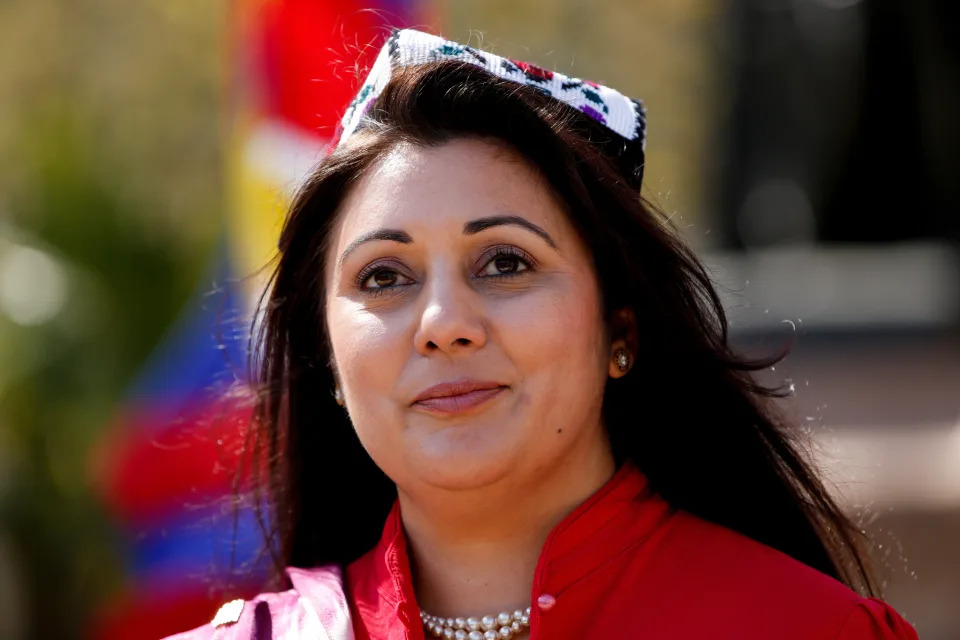
Conservative MP Nusrat Ghani in January claimed she was sacked from a role in the cabinet in 2020 because of her 'Muslimness'. (Getty Images)
Ghani made the initial allegations in January, telling the Sunday Times: "At the post-reshuffle meeting with the whips I asked what the thinking was behind the decision to fire me... I was told that at the reshuffle meeting in Downing Street ‘Muslimness’ was raised as an ‘issue’."
A spokesperson for the prime minister at the time said Ghani had flagged the issue and had not subsequently begun a formal complaints process. Shortly after, Number 10 announced they would investigate the allegation.
Spencer, who was chief Conservative whip during the time Ghani claimed the incident happened, has fiercely denied the claims, saying: "I have never used those words attributed to me."
In February the prime minister promoted Spencer to Leader of the House of Commons.
The exchange follows an investigation into the Conservative Party on Islamophobia after reports of multiple incidents in the party, as as well as Johnson's own comments about Muslim women.
Senior Muslim Conservative politician Sayeeda Warsi said in May last year after the report was published: "The findings of this report show clearly that the Conservative Party is institutionally racist".
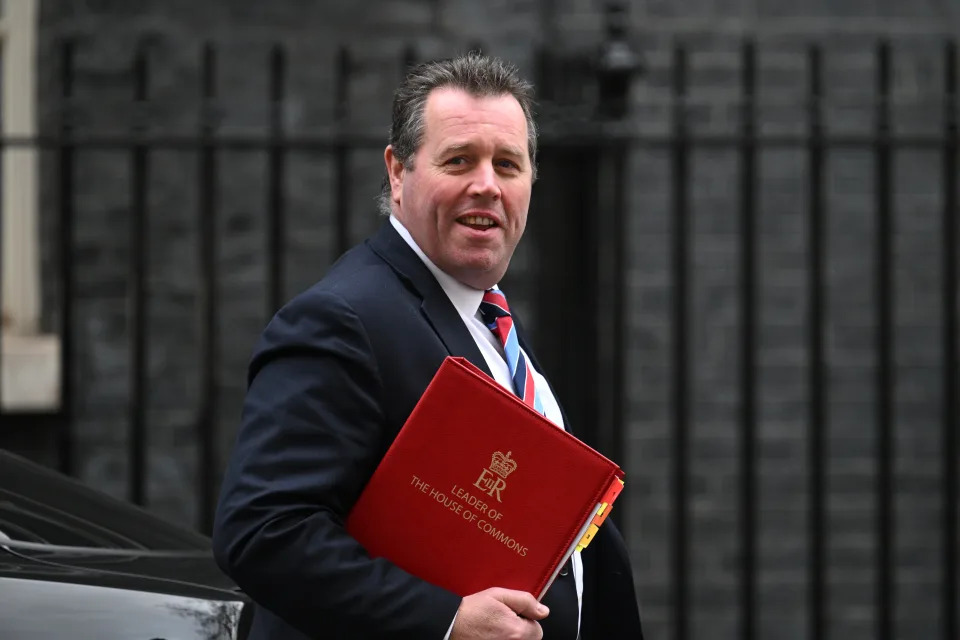
Conservative MP Mark Spencer was promoted to Leader of the House of Commons by Boris Johnson despite allegations of Islamophobia. (Getty Images)
Johnson has previously said he is "sorry for offence taken" for his own remarks, but stopped short of apologising claiming they were a feature of journalism.
"I do know that offence has been taken at things I’ve said, that people expect a person in my position to get things right, but in journalism you need to use language freely," he said.
"I am obviously sorry for any offence taken."
Tell Mama, which tracks anti-Muslim hate crimes in the UK, say incidents jumped by 375% following the prime minister's remarks.
When asked whether Hoyle's decision to cut Hussain off was appropriate, and whether Muslim MPs have the right to challenge the prime minister on the issue in the House of Commons, a spokesperson for Labour said: "It is legitimate question to ask about Islamophobia within the Conservative Party. Whether the Prime Minister’s question time was the right place to do it… that’s a matter for the Speaker to put on what’s appropriate in the House of Commons.”
A House of Commons spokesperson said: "Members should not make accusations about the conduct of other Members as a ‘sideswipe’ as part of a question. In other words, any accusation about a Member’s conduct should only be done in the form of a substantive motion, and not just in passing’."
Women’s History Month: 5 groundbreaking researchers who mapped the ocean floor, tested atomic theories, vanquished malaria and more
The Conversation
March 05, 2022

Tu Youyou shared the Nobel Prize in Physiology or Medicine in 2015.Claudio Bresciani/AFP
Behind some of the most fascinating scientific discoveries and innovations are women whose names might not be familiar but whose stories are worth knowing.
Of course, there are far too many to all fit on one list.
But here are five profiles from The Conversation’s archive that highlight the brilliance, grit and unique perspectives of five women who worked in geosciences, math, ornithology, pharmacology and physics during the 20th century.
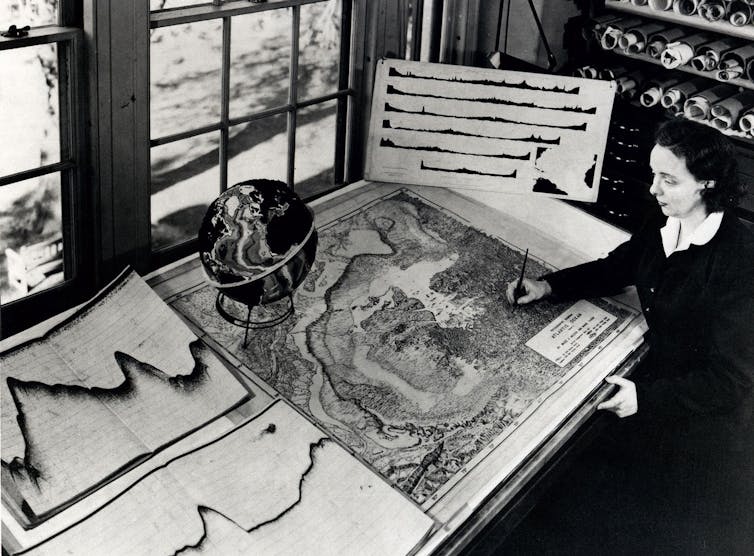
Marie Tharp with an undersea map at her desk. Rolled sonar profiles of the ocean floor are on the shelf behind her.
Lamont-Doherty Earth Observatory and the estate of Marie Tharp
As late as the 1950s, wrote Wesleyan University geoscientist Suzanne OConnell, “many scientists assumed the seabed was featureless.”

An illustration of Marie Tharp’s mapping process. (a) Shows the position of two ship tracks (A, B) moving across the surface. (b) Plots depth recordings as profiles. (c) Sketches features shown on the profiles.
The Floors of the Ocean, 1959, Fig. 1
Enter Marie Tharp. In 1957, she and her research partner started publishing detailed hand-drawn maps of the ocean floor, complete with rugged mountains, valleys and deep trenches.
Tharp was a geologist and oceanographer. Aboard research ships, she would carefully record the depth of the ocean, point by point, using sonar. One of her innovations was to translate this data into topographical sketches of what the seafloor looked like.
Her discovery of a rift valley in the North Atlantic shook the world of geology – her supervisor on the ship dismissed her idea as “girl talk,” and Jacques Cousteau was determined to prove her wrong. But she was right, and her insight was a key contribution to plate tectonic theory. That’s part of why, OConnell writes, “I believe Tharp should be as famous as Jane Goodall or Neil Armstrong.”
2. Sympathetic observation of bird behavior
Margaret Morse Nice was a field biologist who got into the minds of her study subjects to garner new insights into animal behavior. Most famously she observed song sparrows in the 1920s and ‘30s.
Rochester Institute of Technology professor of science, technology and society Kristoffer Whitney recounted what Nice called her “phenomenological method,” acknowledging the obvious “affection and anthropomorphism” you can see in her descriptions.
“When I first studied the Song Sparrows,” Nice wrote, “I had looked upon Song Sparrow 4M as a truculent, meddlesome neighbor; but … I discovered him to be a delightful bird, spirited, an accomplished songster and a devoted father.”
Despite earning no advanced degrees and being considered an amateur, Nice promoted innovations like the “use of colored leg bands to distinguish individual birds,” gained the respect of her better-known peers and enjoyed a long, successful career.
3. A medical researcher in Maoist China

Tu Youyou in a pharmacology lab with a colleague in the 1950s.
Xinhua News Agency via Getty Images
At the height of China’s Cultural Revolution, a young scientist named Tu Youyou headed a covert operation called Project 523 under military supervision. One of her team’s goals was to identify and systematically test substances used in traditional Chinese medicine in an effort to vanquish chloroquine-resistant malaria.
Historian Jia-Chen Fu described how “contrary to popular assumptions that Maoist China was summarily against science and scientists, the Communist party-state needed the scientific elite for certain political and practical purposes.”
Tu followed a hunch about how to extract an antimalarial compound from the qinghao or artemisia plant. By 1971, her team had successfully “obtained a nontoxic and neutral extract that was called qinghaosu or artemisinin.” In 2015, she was honored with a Nobel Prize.
4. A mathematician who wouldn’t be diverted
Not everyone gets called a “creative mathematical genius” by Albert Einstein. But Emmy Noether did.
Mathematician Tamar Lichter Blanks wrote about the roadblocks Noether faced as a Jewish woman who wanted to pursue a math career in early 1900s Germany. For a while, Noether supervised doctoral students without pay and taught university courses listed under the name of a male colleague.
All the while, she conducted her own research in theoretical physics, contributing to Einstein’s theory of relativity. Her most revolutionary work was in ring theory and is still pondered by mathematicians today.
Noether died less than two years after emigrating to the U.S. to escape the Nazis.
5. Testing nuclear theories one by one

A 2021 U.S. postage stamp featuring Chien-Shiung Wu.
U.S. Postal Service
While sometimes called the “Chinese Marie Curie” in her home country, nuclear physicist Chien-Shiung Wu is less well-known in the U.S., where she did the bulk of her work. Rutgers University-Newark physicist Xuejian Wu considered Chien-Shiung Wu (no relation) “an icon” who inspired his own career path.
As a grad student, Wu traveled by steamship to California in 1936, where she fell in love with atomic nuclei research at UC Berkeley, home of a brand new cyclotron. She worked on the Manhattan Project during World War II.
Among her many accomplishments, Wu’s careful experimental work discovered what’s called parity nonconservation – that is, that a physical process and its mirror reflection are not necessarily identical. Her colleagues who focused on the theoretical side of this breakthrough won the 1957 Nobel Prize in physics, but Wu was overlooked.
Editor’s note: This story is a roundup of articles from The Conversation’s archives.
Maggie Villiger, Senior Science + Technology Editor, The Conversation
This article is republished from The Conversation under a Creative Commons license. Read the original article.
IRELAND
Government must act on women’s equality issues, rally told
David Young
Sat, 5 March 2022

People take part in a National Women’s Council of Ireland rally outside Leinster house in Dublin (Niall Carson/PA) (PA Wire)
A rally in Dublin has heard calls for government action to accelerate progress on women’s equality issues in Ireland.
Hundreds of people attended the “No Woman Left Behind” demonstration outside Leinster House.
The rally was organised by the National Women’s Council (NWC) of Ireland ahead of International Women’s Day on Tuesday.

Sinn Fein leader Mary Lou McDonald speaks at a National Women’s Council of Ireland rally outside Leinster House in Dublin (Niall Carson/PA) (PA Wire)
The crowd heard calls for decisive action to tackle violence against women, as well as demands for more to be done to improve provision of childcare and and access to abortion services.
Particular challenges faced by one-parent families and traveller, migrant, trans and disabled women were also highlighted.
Access to state housing was also cited as a major problem.
Addressing the crowds from the platform, NWC director Orla O’Connor said: “It’s an important day for all of us to be here. Today is the day that we want our voices to be heard and it’s time for the government to listen and to take action on the issues affecting our lives.”
She added: “You have told us loud and clear that the key issues affecting women’s equality are not advancing and progress is much, much too slow.”

People take part in the Dublin demonstration (Niall Carson/PA) (PA Wire)
The lead up to the event attracted controversy after it emerged that Government ministers were not on the list of political speakers invited to address the rally.
Organisers defended the move, arguing the event was an opportunity for the Government to listen to the messages being delivered by women.
Sinn Fein leader Mary Lou McDonald was among opposition politicians who did speak at the rally.
She told the event: “We demand the right to decent work, to fair pay, to equal pay, we demand the right to live and raise our families without constant choices to be made between heating the room and feeding a hungry mouth, the right to learn and grow, to explore every horizon, to reach for very dream, we demand the right to be free, to be ourselves, without fear, without apology and without humiliation – the right to live a full and free life together.
“The political system can choose to listen or not, they may choose to look the other way but be very clear sisters – the old Ireland is gone and change is coming.”

Labour TD Ivana Bacik addresses the rally (Niall Carson/PA) (PA Wire)
Ms McDonald also expressed solidarity with the women of Ukraine amid the ongoing war.
“The scenes of horror that we witness daily are matched only by the expressions of incredible courage and bravery as civilians go toe to toe with the Russian aggressor,” she said.
Labour TD Ivana Bacik also used the rally to voice support for Ukraine.
“In a peaceful Dublin city centre I know all our thoughts and all our solidarity are with the women, children and people of Ukraine as they endure the brutal bombardment and assault from Russian troops and Russian forces,” she said.
“At this, their darkest hour, we stand with them and we condemn this appalling and brutal invasion.”
PATRIARCHY IS FEMICIDE
Male violence against women is about so much more than toxic masculinitySonia SodhaSun, 6 March 2022 Photograph: Ian West/PAThe murder of Sarah Everard by a serving police officer a year ago prompted a wave of national shock. Her brutal abduction, rape and killing pierced the public consciousness to such a degree that feminist campaigners wondered if this tragedy might move us from seeing violence as something society has to live with to something that can be significantly reduced.Today, those hopes look misplaced. A single statistic shows how little has changed: since Sarah’s murder, at least 125 women have been killed by men. Some, like Sabina Nessa, were murdered in a public place by a man they didn’t know; many more behind closed doors, often by their partners. The question, after having read report after report, is why, for all the never agains and pledges to do more, have we failed so badly to reduce violence?Any analysis of violence has to begin with the stark difference between the sexes. The vast majority of violence is committed by men – more than four-fifths of violent crime and an even greater proportion of sex offences. While men are also more likely to be victims of violent crime, women are overwhelmingly more likely to be victims of severe domestic abuse. (One of the reasons single-sex spaces have become the norm in prisons, hospital wards and refuges: it is a simple rule of thumb to safeguard against male violence.)Interestingly, the difference in physical aggression between the average man and the average women is moderate – to put it in context, about a quarter as significant as average sex differences in height. The big difference comes at the extremes of the distribution: there are many more very violent men than women.What underpins this difference? In animals, scientists have found a clear link between testosterone levels and male aggression. But this is not replicated in humans, leading experts to believe that the complex interaction between genetic and environmental factors – the way children are socialised – plays a much greater roleA UK project has shed the feminist attachment to the idea that the key to reducing violence is teaching men to be betterAnd there are noticeable differences in the way boys and girls are socialised. Children’s worlds are infused with harmful gender stereotypes – the idea that girls are sweet and boys are tough – in everything from behaviour expectations to their toys and clothes. There are some school-based programmes that try to tackle damaging masculine stereotypes, which draw on evidence of the effectiveness of peer-based programmes to tackle bullying in encouraging friends to call each other out on unhealthy behaviour towards girls. It can only be a good thing to challenge the stereotypes that are corrosive to boys and girls.Perpetrator programmes for violent men have also run with this idea of reprogramming masculinity. That makes sense when you consider that, a few decades ago, the only people interested in reducing domestic violence were grassroots feminists who understood male violence primarily as a symptom of patriarchy: the age-old structural power imbalance between men and women that socially constructed itself out of differences between the sexes. They developed the Duluth model, named after the Minnesota city where it was conceived in the 1980s, which included a curriculum that aimed to educate the patriarchy out of perpetrators.It is used widely today in the US, the UK and Australia, but evidence of its effectiveness is equivocal at best. That is not altogether surprising: the idea that attending a weekly support group will transform lifelong patterns of violent behaviour for most men seems far-fetched.The difference between the sexes is a vital starting point for understanding violence, but cannot be the endpoint. Just as important are differences between men: why are some more violent than others? Some will have the kinds of personality disorders that mean they are incapable of feeling empathy. But longitudinal research finds that adverse childhood experiences – such as parental or domestic abuse, having a father in prison or growing up around alcohol or substance abuse – are associated with poorer outcomes in adulthood for boys and girls and one of those outcomes for some boys is a greater propensity to violence.Yet the services that exist to support children with trauma have been cut to the bone over the past decade. It is not to excuse adult violence to say that some perpetrators have been resoundingly failed as children.This difference between men has also been elided when it comes to perpetrator programmes. One of the most effective is a UK project called Drive, developed by two domestic abuse charities. It has shed once and for all the feminist attachment to the idea that the key to reducing serious violence is teaching men to be better. It works with the highest-risk domestic abusers. They are all assigned a case manager, who can help them access the support they need, such as housing or mental health services.But it also functions as a surveillance system for dangerous men: they are monitored on an ongoing basis and case managers bring in other agencies such as the police and social services to disrupt their violent behaviour. The results are stunning: an 82% and 88% sustained drop in physical and sexual abuse respectively. But just 1% of serious domestic abuse perpetrators get funnelled into targeted interventions. If we were serious about reducing violence, we would be channelling money into a national rollout of this programme in the same way we spend vast sums on counter-terrorism.Long-standing research shows that alcohol restrictions produce beneficial health outcomes and reduce violenceThis idea that we need to disrupt rather than try to fix dangerous men has other implications. There is longstanding research that shows that alcohol restrictions – policies such as minimum pricing, limits on sales of strong alcohol in violence hotspots and timing restrictions – produce not only a range of beneficial health outcomes, but reduce violence. Of course they are a superficial lever and there is much they don’t address, but they reduce harm. Which raises the question: why don’t we use them more?I ended up in a different place than I imagined I would when I embarked on a new documentary for Radio 4. Of course, you cannot understand violence without understanding differences between the sexes, but male violence is about much more than toxic masculinity. And we need to put the same effort into disrupting violent men from killing their partners as we do in stopping them from committing dreadful acts of terrorism.• Sonia Sodha is an Observer columnist
Photograph: Ian West/PAThe murder of Sarah Everard by a serving police officer a year ago prompted a wave of national shock. Her brutal abduction, rape and killing pierced the public consciousness to such a degree that feminist campaigners wondered if this tragedy might move us from seeing violence as something society has to live with to something that can be significantly reduced.Today, those hopes look misplaced. A single statistic shows how little has changed: since Sarah’s murder, at least 125 women have been killed by men. Some, like Sabina Nessa, were murdered in a public place by a man they didn’t know; many more behind closed doors, often by their partners. The question, after having read report after report, is why, for all the never agains and pledges to do more, have we failed so badly to reduce violence?Any analysis of violence has to begin with the stark difference between the sexes. The vast majority of violence is committed by men – more than four-fifths of violent crime and an even greater proportion of sex offences. While men are also more likely to be victims of violent crime, women are overwhelmingly more likely to be victims of severe domestic abuse. (One of the reasons single-sex spaces have become the norm in prisons, hospital wards and refuges: it is a simple rule of thumb to safeguard against male violence.)Interestingly, the difference in physical aggression between the average man and the average women is moderate – to put it in context, about a quarter as significant as average sex differences in height. The big difference comes at the extremes of the distribution: there are many more very violent men than women.What underpins this difference? In animals, scientists have found a clear link between testosterone levels and male aggression. But this is not replicated in humans, leading experts to believe that the complex interaction between genetic and environmental factors – the way children are socialised – plays a much greater roleA UK project has shed the feminist attachment to the idea that the key to reducing violence is teaching men to be betterAnd there are noticeable differences in the way boys and girls are socialised. Children’s worlds are infused with harmful gender stereotypes – the idea that girls are sweet and boys are tough – in everything from behaviour expectations to their toys and clothes. There are some school-based programmes that try to tackle damaging masculine stereotypes, which draw on evidence of the effectiveness of peer-based programmes to tackle bullying in encouraging friends to call each other out on unhealthy behaviour towards girls. It can only be a good thing to challenge the stereotypes that are corrosive to boys and girls.Perpetrator programmes for violent men have also run with this idea of reprogramming masculinity. That makes sense when you consider that, a few decades ago, the only people interested in reducing domestic violence were grassroots feminists who understood male violence primarily as a symptom of patriarchy: the age-old structural power imbalance between men and women that socially constructed itself out of differences between the sexes. They developed the Duluth model, named after the Minnesota city where it was conceived in the 1980s, which included a curriculum that aimed to educate the patriarchy out of perpetrators.It is used widely today in the US, the UK and Australia, but evidence of its effectiveness is equivocal at best. That is not altogether surprising: the idea that attending a weekly support group will transform lifelong patterns of violent behaviour for most men seems far-fetched.The difference between the sexes is a vital starting point for understanding violence, but cannot be the endpoint. Just as important are differences between men: why are some more violent than others? Some will have the kinds of personality disorders that mean they are incapable of feeling empathy. But longitudinal research finds that adverse childhood experiences – such as parental or domestic abuse, having a father in prison or growing up around alcohol or substance abuse – are associated with poorer outcomes in adulthood for boys and girls and one of those outcomes for some boys is a greater propensity to violence.Yet the services that exist to support children with trauma have been cut to the bone over the past decade. It is not to excuse adult violence to say that some perpetrators have been resoundingly failed as children.This difference between men has also been elided when it comes to perpetrator programmes. One of the most effective is a UK project called Drive, developed by two domestic abuse charities. It has shed once and for all the feminist attachment to the idea that the key to reducing serious violence is teaching men to be better. It works with the highest-risk domestic abusers. They are all assigned a case manager, who can help them access the support they need, such as housing or mental health services.But it also functions as a surveillance system for dangerous men: they are monitored on an ongoing basis and case managers bring in other agencies such as the police and social services to disrupt their violent behaviour. The results are stunning: an 82% and 88% sustained drop in physical and sexual abuse respectively. But just 1% of serious domestic abuse perpetrators get funnelled into targeted interventions. If we were serious about reducing violence, we would be channelling money into a national rollout of this programme in the same way we spend vast sums on counter-terrorism.Long-standing research shows that alcohol restrictions produce beneficial health outcomes and reduce violenceThis idea that we need to disrupt rather than try to fix dangerous men has other implications. There is longstanding research that shows that alcohol restrictions – policies such as minimum pricing, limits on sales of strong alcohol in violence hotspots and timing restrictions – produce not only a range of beneficial health outcomes, but reduce violence. Of course they are a superficial lever and there is much they don’t address, but they reduce harm. Which raises the question: why don’t we use them more?I ended up in a different place than I imagined I would when I embarked on a new documentary for Radio 4. Of course, you cannot understand violence without understanding differences between the sexes, but male violence is about much more than toxic masculinity. And we need to put the same effort into disrupting violent men from killing their partners as we do in stopping them from committing dreadful acts of terrorism.• Sonia Sodha is an Observer columnist















